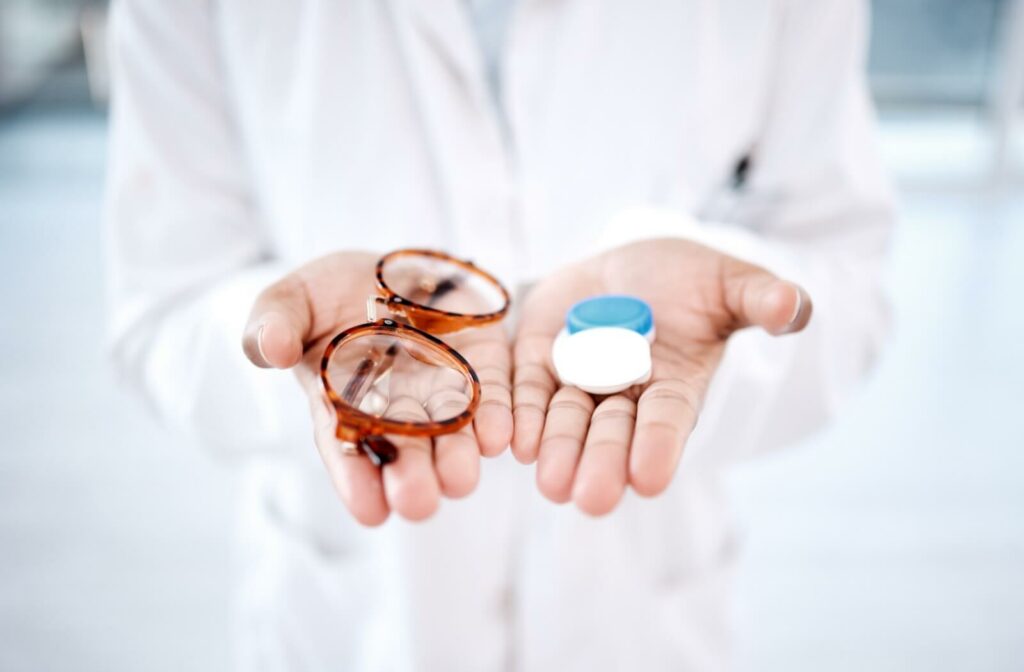When it comes to correcting vision, glasses and contact lenses are two of the most popular options. However, many people wonder whether the prescriptions for these vision aids are the same.
While they might seem interchangeable, there are significant differences between glasses and contact lens prescriptions. Understanding these differences is crucial for ensuring you receive the right vision correction for your specific needs.
At Total Focus Family Optometry, we are dedicated to providing comprehensive and personalized eye care for every member of your family. Our experienced professionals use the latest technology to make sure of accurate prescriptions and optimal eye health. Whether you need glasses, contact lenses, or a thorough eye exam, trust us to help you see clearly and comfortably.
The Basics of Vision Prescriptions
A vision prescription is a detailed document from an eye care professional that outlines the specific parameters needed to correct your vision. It includes measurements related to the curvature and shape of your eyes, the level of vision correction required, and other factors.
Elements in a Prescription:
The elements in a prescription may look foreign, but they needn’t be:
- ADD refers to the additional lens power required to enhance reading vision. This value appears on prescriptions for reading glasses or the lower section of bifocal or progressive lenses.
- Axis is a number ranging from 1 to 180, indicating the precise location of astigmatism in your eye.
- BO, BI, BU, BD denote base out, base in, base up, and base down, respectively. These abbreviations specify where to position the prism on eyeglasses designed to correct double vision.
- CYL, short for cylinder, indicates the degree of astigmatism in your eye. Together with the axis, it helps correct this vision issue.
- DV stands for distance vision, showing whether you are nearsighted or farsighted.
- NV represents near vision, signifying the additional power needed to facilitate reading.
- OD means oculus dexter, referring to your right eye.
- OU stands for oculus uterque, meaning both eyes.
- OS is oculus sinister, referring to your left eye.
- PD denotes pupillary distance. Monocular PD is the distance from your pupil to the center of your nose, while binocular PD is the distance between your pupils.
- Prism measures the prismatic power necessary to correct double vision by aligning the eyes properly.
- SPH stands for sphere, indicating the lens power needed to correct your vision.
Differences Between Glasses & Contact Lens Prescriptions
While both glasses and contact lens prescriptions aim to correct vision, their differences arise from how each appliance interfaces with your eyes.
Distance from the Eye
- Glasses: Sit about 12 millimeters from the eyes.
- Contacts: Rest directly on the cornea.
This difference in distance can significantly affect the strength of the prescribed lenses. Contact lenses require more precise measurements to fit directly on the eyes’ surface.
Base Curve & Diameter
Contact lens prescriptions include two additional parameters not found in glasses prescriptions:
- Base Curve (BC): Measures the curvature of the back surface of the contact lens.
- Diameter (DIA): Indicates the size of the lens from edge to edge.
These measurements ensure a proper fit, comfort, and optimal vision correction, as incorrectly fitted contact lenses can cause discomfort and even damage to the eye.
Additional Considerations
- Material and Brand: Contact lens prescriptions may specify the type of material and brand, as different brands have varied designs and water content.
- Tear Film and Corneal Shape: Specialists consider the tear film and corneal shape, which are less critical for glasses but essential for contact lenses due to their direct contact with the eye.
Why the Difference Matters
Using a glasses prescription to order contact lenses (or vice versa) can lead to improper vision correction, discomfort, and potential eye health issues. An accurate prescription tailored to the specific type of vision correction aid is essential for optimal results.

Getting the Right Prescription
To make sure that you receive the correct prescription, always visit a qualified eye care professional. They will conduct a comprehensive eye exam and provide distinct prescriptions for glasses and contact lenses if needed.
Tips for a Successful Eye Exam:
- Discuss Your Preferences: Inform your eye care provider about your preference for glasses, contacts, or both.
- Follow the Guidelines: Adhere to the recommended wearing schedule and care instructions for contacts.
- Schedule Regular Check-ups: Attend regular eye exams to update your prescription and ensure optimal eye health.
Clear Vision Ahead: Understanding Your Prescription Differences
Glasses and contact lens prescriptions are not the same due to differences in how they interact with your eyes and the specific measurements required for contact lenses. Making sure that you have the correct prescription for each type of vision correction aid is vital for maintaining clear vision and overall eye health.
For personalized advice and prescriptions, consult with your eye care professional at Total Focus Family Optometry. We will help you determine the best options for your individual needs, making sure that you see clearly and comfortably, whether you choose glasses, contact lenses, or both.Take the first step towards better vision and eye health by scheduling an appointment with us at Total Focus Family Optometry. Our dedicated team of eye care professionals is ready to provide you and your family with personalized eye care using the latest technology.



